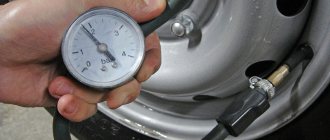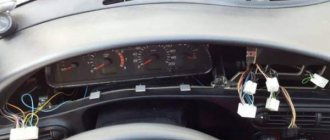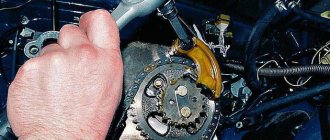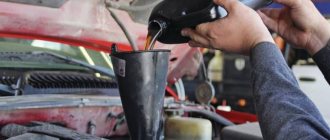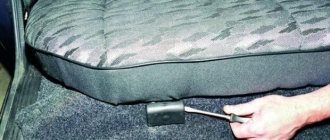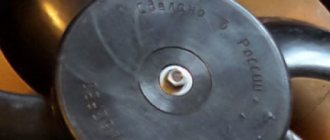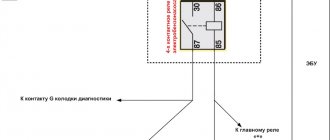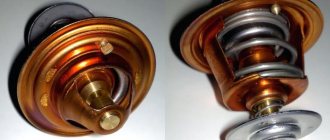We remove the collector and spider for convenience)
There are many ways to plug the return flow from the stove: 1. Which is what I used - cut it off before the outlet to the manifold and plug it with a bolt, lubricated with sealant, or put on a pipe and plug it. 2. The simplest one is to put a piece of pipe on the end and clamp it. 3. Unscrew the entire tube and cut out a plug from a piece of metal, drill holes and cover everything with sealant and tighten it.
I used the second method, cut it off, coated it with sealant and capped it with a bolt.
Recently I began to notice that the coolant temperature arrow on the dashboard on a warm car shows 80-85 degrees no more
...and it’s even more interesting in a traffic jam in winter (it can creep beyond 90 degrees). After googling the Shniva forum, I discovered the reason... THERMOSTAT. Without hesitation, I decided to replace this “penny” part. In the Lada-Detal store, the thermostat Chevy Niva 2123-1306010 costs exactly 500 rubles (plus for the domestic auto garden - I bought a “thermos” the other day on a Pegeon - original Gates 1970 rubles. The difference is noticeable). In the LADA-do box there was a thermostat from the manufacturer T/A (Thomas Auto).
supposedly an original that is installed at the factory. I didn’t take a long time to choose a manufacturer (and there are at least 4 of them) because the manager in the store diligently assured that it was really high quality + I checked everything right away in the old way - I blew into the “large circle” outlet - it doesn’t let through. Ok, let's take it. (I thought))) Then we google and understand that changing the thermostat yourself is as easy as shelling pears, having in your arsenal a minimal set of tools, a warm garage and a good friend)) We drove it into the garage, cooled it for about 20 minutes, removed the hose from the coolant tank, drilled it into the old one there was a hole in the lid of the coolant tank (the lid remained after replacing the coolant tank), we connected a car compressor through a hose to inflate tires (so as not to blow into the tank ourselves) and “squeezed out” a couple of liters of antifreeze through the return line, then removed the hose supplying coolant to the throttle body and squeezed it out again grams 500. Next, calmly loosen the thermostat clamps, remove the old one and install the new one. Here is the new handsome guy
new TOMOS - car, pull the clamps, fill in antifreeze, remove the hose supplying coolant to the throttle body to bleed the air - bleed the air, put it back on and tighten it.
Antifreeze ARCTIC Here he is, an old man. I checked in the same way - I blew into the “large circle” outlet - it blows out easily. CONCLUSION - not working.
old Started the car, drove it out into the street, warmed it up to 90, tightened the clamps again. ALL OK. p.s. changed on 01/22/2016, today (01/25/2016) in the morning it was -22 outside, the coolant warmed up to 90 degrees. the arrow stands straight, not moving anywhere, the car is warm, everything is fine.
Lada 2107 ツツツ LADA RAZVOLUTION® › Logbook › ➀➅➀✍ Thermostat 2123 Chevrolet Niva…
I went, I went. The temperature with the stove open was 80 degrees all the time. When I close the stove a little 2 degrees it warms up. This is not a problem for winter at all. It also took a long time to warm up. I decided to change it before it gets too cold. I bought it from a Chevrolet Niva.
In our village I found such a Pramo thermostat for 80 degrees, also Luzary, there is nothing else, the choice is off the charts))). The old standard Luzar was also 80 degrees. The asking price for a new one is 300 rubles. Later I’ll look for something better, if I’m lucky I’ll take it to 85 degrees.
Tuning of the Niva 2121 engine, modification of the intake system for the VAZ engine with your own hands, VAZ 2131, chip tuning of the Niva 2131 engine. Modernization of diffusers of the Niva 2131, VAZ 2121. Tuning of VAZ cars is an increase in the factory characteristics of the car. Refinement of the Niva 2121 is, first of all, the installation of new bumpers, crankcase protection, and a winch. If desired, the owners of these SUVs install additional fog lights. Our sections describe instructions and tips for modifying the Niva 2131 of various units, such as the transfer case, etc. Even a car enthusiast can do complex tuning of vases with his own hands. You will also find categories for engine tuning, gearbox tuning, interior and exterior tuning, as well as many photo reports of VAZ 2121 tuning. Thanks to interesting solutions, Niva tuning will give you a lot of pleasure and benefits. If you have photos of tuning vases, send them to us by email.
We buy:
Thermostat LUZAR — 340 rub. Set of pipes LUZAR VAZ 21213 - 300 rub. Clamps in assortment 200 rub. (a few left) Hose Ø16mm - 90 rub. meter (I took a meter) Sealant - 40 rubles. There was about 0.5 liters of antifreeze. Let's start the installation: Drain the antifreeze, dismantle the thermostat along with the pipes. We are figuring out the location of the new thermostat, I decided to put it higher and in a horizontal position, as was done on Shnivy. We cut the pipes according to location. In general, nothing complicated, except for a couple of points: I plugged the outlet from the stove into the block with a stud of the GAZelle wheels, ran a hose from the outlet pipe of the stove to the VAZ 2131 thermostat (there is an electric pump in the section), to the carburetor heating nipple (on the Niva 2121 thermostat ) put on a suitable hose and plugged it with a bolt. Fill with antifreeze and remove the plugs. ALL! Installation time - 4 hours with swearing and smoke breaks, without much stress. It feels like - I start the car, turn on the heater - warm air blows from the heater when the needle moves to o, as it warms up the heat increases. As a result, at idle the car warmed up to 80 degrees in about 7 minutes! At an outside temperature of -13°C, while driving the engine warmed up to 90°C and the needle froze... Hot air came out of the stove, and then the “Piano in the Bushes” came in, or rather the electric pump from the GAZelle! And this whole thing is blown through by a heater motor from a VAZ-2108! Can you imagine what Tashkent is like? And I felt the RESULT:
With the heater on, the car warmed up to operating temperature, just like with the original one WITHOUT turning on the heater! The engine operating temperature reached REAL 90°C. Due to its simplicity, cheapness and USEFULNESS, I advise you to take care of this alteration. Due to the transfer of the thermostat higher, to replace it it is enough to drain the antifreeze from the stove-thermos pipe, unscrew the 4 clamps and repeat the assembly in the reverse order. I'm happy, like an elephant! Plus, it seems to me that the plugged “nipple” for heating the VAZ 2121 carburetor can be used to bleed air from the system, so it is level with the intake manifold.
Chevrolet Niva thermostat for classic
Hi all! I decided to improve the cooling system, and decided that the thermostat would be first in line. My native didn’t want to install it. I found an idea with a thermostat from a Chevrolet Niva 2123, and decided to install it. I searched a lot on the Internet, but not everything is clear everywhere, and not everything is visible from the photo, so I decided to make everything as clear and visual as possible. And so let's go: What you need: 1. The thermostat itself from Sheviniva 2. For different cases of muffling the return line, different plugs (I'll tell you which ones later) 3. Hose d18mm. about 1 meter for the return line and a hose that goes to the manifold (d8mm) 4. Sealant 5. A set of original radiator pipes (not necessarily like mine, the usual standard ones (black) will do).
We remove the collector and spider for convenience)
There are many ways to plug the return flow from the stove: 1. Which is what I used - cut it off before the outlet to the manifold and plug it with a bolt, lubricated with sealant, or put on a pipe and plug it. 2. The simplest one is to put a piece of pipe on the end and clamp it. 3. Unscrew the entire tube and cut out a plug from a piece of metal, drill holes and cover everything with sealant and tighten it.
I used the second method, cut it off, coated it with sealant and capped it with a bolt.
Recently I began to notice that the coolant temperature arrow on the dashboard on a warm car shows 80-85 degrees no more
...and it’s even more interesting in a traffic jam in winter (it can creep beyond 90 degrees). After googling the Shniva forum, I discovered the reason... THERMOSTAT. Without hesitation, I decided to replace this “penny” part. In the Lada-Detal store, the thermostat Chevy Niva 2123-1306010 costs exactly 500 rubles (plus for the domestic auto garden - I bought a “thermos” the other day on a Pegeon - original Gates 1970 rubles. The difference is noticeable). In the LADA-do box there was a thermostat from the manufacturer T/A (Thomas Auto).
supposedly an original that is installed at the factory. I didn’t take a long time to choose a manufacturer (and there are at least 4 of them) because the manager in the store diligently assured that it was really high quality + I checked everything right away in the old way - I blew into the “large circle” outlet - it doesn’t let through. Ok, let's take it. (I thought))) Then we google and understand that changing the thermostat yourself is as easy as shelling pears, having in your arsenal a minimal set of tools, a warm garage and a good friend)) We drove it into the garage, cooled it for about 20 minutes, removed the hose from the coolant tank, drilled it into the old one there was a hole in the lid of the coolant tank (the lid remained after replacing the coolant tank), we connected a car compressor through a hose to inflate tires (so as not to blow into the tank ourselves) and “squeezed out” a couple of liters of antifreeze through the return line, then removed the hose supplying coolant to the throttle body and squeezed it out again grams 500. Next, calmly loosen the thermostat clamps, remove the old one and install the new one. Here is the new handsome guy
new TOMOS - car, pull the clamps, fill in antifreeze, remove the hose supplying coolant to the throttle body to bleed the air - bleed the air, put it back on and tighten it.
Antifreeze ARCTIC Here he is, an old man. I checked in the same way - I blew into the “large circle” outlet - it blows out easily. CONCLUSION - not working.
old Started the car, drove it out into the street, warmed it up to 90, tightened the clamps again. ALL OK. p.s. changed on 01/22/2016, today (01/25/2016) in the morning it was -22 outside, the coolant warmed up to 90 degrees. the arrow stands straight, not moving anywhere, the car is warm, everything is fine.
Lada 2106 › Logbook › Thermostat from Shnivy to Classic
They soldered the main radiator in two places... The heater radiator was not touched, the reason is trivial, the faucet was not fully open (fucking Luzar). And at the same time I bought a thermostat from Shnivy. The choice was small, either Luzar or VAZ. Having bitter experience with the Luzar company, I took the VAZ, although it was almost 200 rubles more expensive. What you will need: 1) A thermostat from a Chevy Niva 2) Several Zhiguli pipes that come from a standard thermostat 3) A hose with a diameter of 18 mm and a length of 1 m 4) I don’t remember what diameter the hose is, but it would fit on the thinnest outlet on a new thermos 5) A bunch of different clamps sizes (just don’t take the above-mentioned company such a g... because of them this whole thing has been delayed.) 6) Antifreeze about 10 liters 7) Two bolts or plugs (can be purchased at any plumbing store) Straight arms and a partner (you can do it with beer) Let’s get started : Drain the antifreeze. We remove all the pipes (the inlet from the head to the stove can be left untouched). Next, we turn off the two outputs from the tube that goes from the pump to the stove. I plugged it in a simple way: on one outlet, which had a larger diameter, I put a pipe that went to the stove, cut it off and put a plug, tightened it with a clamp, and in the second, which went to heating the carb, I screwed in a bolt and also tightened it with a clamp. Next we are going to adjust the thermostat. First you need to adjust the pipe that comes from the radiator. We took the old one and turned it around, i.e. the part that was put on the radiator is now put on the thermostat and it was trimmed by 5 cm. Now the thermos is turned as it should and has risen a little higher. The old pipe, which goes from the thermos to the pump, is short, so we cut any purchased one so that there is a straight piece without bends, 10 cm. The upper one, which goes to the head, can be left old. Next, we measure and cut a thin hose; it will go from the manifold to the thin outlet of the thermostat. I also measured an 18mm hose from the outlet from the stove to the one remaining on the thermostat (we took it with a reserve, the reserve turned out to be large and the hose broke in one place, but nothing was done to tie it to the body with ties). At this point the fitting process is completed, you can tighten the clamps. Well, then we fill in antifreeze and expel all the air)) I expelled it in the following way: I disconnected the hose from the manifold and the 18mm hose from the stove to the thermos on the thermos side. Open the stove tap. Through the funnel we begin to pour antifreeze into the hose from the stove. As soon as the antifreeze flows from the thermostat, put on the hose into which it was poured and tighten it with a clamp. Next we pour it into the radiator. As soon as it runs from the collector, we put the remaining hose there. We start it up and keep the revs at 3-4 thousand while adding fuel to the radiator... Impressions: On the old thermostat, even with + temperament outside, it managed to cool down, and the fan turned on every 10 seconds when heating up. Now the engine has quickly reached operating temperature, it’s already -5 outside and there’s wind, the cooling doesn’t turn on, it’s Tashkent in the cabin, it’s burning my fingers)). Satisfied in one word)) I’ll check it completely in winter))
Grant thermostat for VAZ classic
Ivan Ivanov
Vladimir Sedov
Where to get a plate for converting a thermostat
Vladimir Shevkun
Perhaps in winter the engine began to warm up to operating temperature much faster?
Rafael Zyabbarov
boo boo boo boo show me the diagram.
IG-Technique
I have a classic engine with a volume of 1.6 liters, compression ratio = 13.11 compression = 16 kg/cm2, standard cooling system, aluminum radiator, in the summer on hot days the temperature in the engine compartment reaches 80 degrees Celsius, everything works and does not overheat.
Alex Andropov
Show me how it works on the car.
Andrey Vasiliev
Look, if you change the iron tube on the pump to another one where the piss is located near the stove, will it be better or will the circulation be better or worse?
Vladimir Shestakov
Sanya SHS
Damn how many people have you fooled here!
Sanya SHS
How will he behave when we close the stove tap in the summer? The circle will close. There is no faucet on the grant and it is designed for the grant, there is no need to deal with bullshit.
An interesting option, but for a small circle the diameter of the siphon will be too small, there will be an additional load on the pump, as well as on the engine itself at increased speeds, the excess resistance will begin to take away torque when working only on a small circle, just like the power and efficiency of the engine, and it is also possible cavitation in the pump which will kill the impeller and more. It is already there; when disassembling, you can see how the liner of the first cylinder opposite the pump outlet is snapped. Plus, the supply to the stove will need to be organized through a tee, otherwise, with the valve covered and especially closed, the above-described effect will only intensify, and the engine without circulation will generally overheat, especially the cylinder head. I wouldn’t risk betting in this option. It seems to me that you need to throw out the saxophone, make one similar to the diameter of the Grant hose and turn around the pump inlet, or turn it off, and make a tee between the hose going to the bottom of the radiator and the pump and connect a small circle from the thermostat there, to which the stove will also be connected through a tee , the entrance to the stove will remain standard from the head.
Timoha
The scheme only works in winter
Andrey xXx
There is a connection diagram that is more informative.
Alexander Vovchuk
Many thanks to the author! I installed this thermostat today. I didn’t bother with the adapter plate, but simply welded the thermostat to the outlet pipe, cutting off all the excess from it (after removing the inside of the thermostat for the duration of welding). In the Tashkent cabin, the temperature according to the sensor is a little more than 90°, and the engine warms up much faster. Very pleased, thank you again. Niva 21213
dub0shit
Handsome!! I was thinking about this too! Now I’ll definitely do it just a little differently, I have a classic 16V
Alex Andropov
Show me how it works on the car
Alex Andropov
Where did you put the lower pipe on the radiator?
Vadik Baiush
Where will you connect the collector?
Bakha Turganov
Mator also from grants puts ato classic shit
Itisgoingtopomoika
Please tell me which radiator of the sword you installed to replace the Odov one?
Installing a thermostat from 2123 (Chevrolet Niva) on a Classic VAZ 2107 2105
- https://www.niva-faq.msk.ru/tehnika/dvigatel/sis_ohl/tsshn.htm
- https://www.niva-faq.msk.ru/tehnika/dvigatel/sis_ohl/st.htm
The thermostat from Shniva fits onto thick radiator pipes (aluminum radiator with electric fan) without any problems. The only thing for complete happiness was that the lower radiator hose was turned upside down (the end going to the thermostat was moved towards the radiator) and shortened
5 mm. But this must be selected live. The links above describe how fellow nivovods muffle the entrance to the pump, to which a tube is connected through which antifreeze from the stove and from the intake manifold is drained. But I’m lazy and I’m too lazy to pick out this tube from behind the starter and make a plug for the pump. And therefore, the old antifreeze drain hose from the intake manifold is cut and plugged with a suitable bolt, and the 16 mm antifreeze drain hose from the stove is removed from the brass pipe protruding into the engine compartment and plugged with a fitting for a 16 mm hose with a cap. In this context, a fitting means a plumbing adapter: on one side there is a herringbone thread for fixing the hose, on the other side there is a thread. In order to plug the fitting, screw the cap onto it. When purchasing, do not forget about the rubber sealing ring, which should be in the lid or purchased separately.
The fitting on the thermostat under the heater for the hose is 18-20 mm, and we have a drain fitting from the heater radiator of 16 mm. It would be necessary to organize a transition from one hose size to another. The transition is organized using a fitting for a hose 16 mm 1/2″ - coupling 1/2″ - 18 mm 1/2″. That is, we screw the threaded parts into the coupling, not forgetting to seal them with tow or special plumbing tape, and insert the herringbone notches into the hoses under the clamps. A 1/2″ ball valve can also be used as a coupling, especially for those who are fed up with the stove faucet and would prefer to open the hood and open or close the ball valve. It can be even simpler - find in a plumbing store a plastic adapter between 16 and 18 mm hoses, which ends in 16 and 18 mm herringbones. A regular 18 mm hose is still inconvenient to connect to the thermostat. It will be too close to the exhaust manifold pipes, and it will be somewhat shapeless. I recommend using a figure-eight, S-Yu-shaped hose. It is the longest and is similar in shape to an integral; on one side of the hose it has a widening pipe. So, how does the drain hose go from the stove drain fitting:
drain fitting 16 mm - hose 16 mm towards the wing - transition from 16 to 18 mm - the figure-eight hose continues to move towards the wing, and then goes down, then again a horizontal platform and by widening the pipe we connect to the thermostat. Photos in two planes explain the idea of laying the hose away from the exhaust manifold
At the moment, in addition to the thermostat, I also have an electric pump from Gazelle and the drain from the stove does not go to the thermostat immediately, but first to the pump. There are old-style electric pumps for a 16 mm hose and a new one for a 20 mm hose. I have the old model. The pump is screwed onto the studs of a standard ignition coil, which I don’t have, so I use an MPSZ-ZH. The pump fits perfectly onto the standard ignition coil mounting studs... True, it’s on the left wing, but I have a hose of the required length. Therefore, I lay a hose from the stove drain fitting to the pump. the hose runs between the valve cover and the thick radiator hose. After the pump, from a 16 mm hose there is a transition to an 18 mm hose, which is connected to the fitting of the thermostat heater.
Collapsible thermostat for classics
look at the photo
The screw thermostat has 2 additional pipes: for the expansion tank (it is installed on the right on these machines) and for the heater return.
We don’t need a fitting for the expansion tank (but we can pull the hose there on the left to organize “bottom replenishment”), I plugged it (cut an M8 thread and tightened the bolt with the FUM).
but the stove return fitting deserves very close attention. And here's why: let's remember where the slurry drains from the stove. That's right, into the steel pipe at the end of the pump. Those. after the thermostat. And the thermostat knows nothing about the fact that cold liquid appeared after it. In reality, this means that the heater cools the engine, and its temperature drops significantly, and the thermostat cannot do anything.
Connecting the heater return hose to the thermostat makes it (the thermostat) work more meaningfully. And now he takes into account the heat taken by the stove. As a result, the engine warms up better, the fluid in the stove is also hotter, which significantly increases its (stove) efficiency.
I did this a long time ago, on a stock thermostat from 1975. zero-eleven, soldered the pipe there. And here is the finished product.
in short, recommendations from the best dog breeders
the standard steel pipe into which the stove return flowed must be plugged in any convenient way
Re: thermostat from shnivy for classics
Unread message Misha » Thu Jan 29, 2015 20:11:10
Before you judge the mistakes of others, pay attention to yourself. One who throws dirt cannot have clean hands.
Re: thermostat from shnivy for classics
Re: thermostat from shnivy for classics
Unread message by VladiZlav » Thu Jan 29, 2015 20:22:08
Re: thermostat from shnivy for classics
Unread message Sabr » Thu Jan 29, 2015 20:22:56
Reliable operation of the cooling system!
Added after 1 minute 21 seconds: Well, the frying stove too
Added after 24 minutes 47 seconds: No one else will say anything about the thermostat from the shnivy?
Re: thermostat from shnivy for classics
Unread message Meart » Thu Jan 29, 2015 21:10:01
Re: thermostat from shnivy for classics
Re: thermostat from shnivy for classics
Unread message Misha » Thu Jan 29, 2015 21:30:32
Before you judge the mistakes of others, pay attention to yourself. One who throws dirt cannot have clean hands.
Re: thermostat from shnivy for classics
Re: thermostat from shnivy for classics
Unread message Violent » Fri Jan 30, 2015 5:11:34 AM
Re: thermostat from shnivy for classics
Unread message Sabr » Fri Jan 30, 2015 5:38:46 AM
Added after 3 minutes 6 seconds: Should the fan have turned on? I drove the antifreeze in a small circle. Or does it make no difference? But then why would a fan cool an already cold radiator? Unfortunately there is no BC.
Goal: to increase and quickly regulate the engine coolant temperature.
Means: we will need the Chevrolet Niva thermostat itself, M8x12 bolt - 1 pc., M5x40 bolt - 1 pc., M5 nut - 1 pc., internal roofing washer. diameter 5 mm - 1 pc., and possibly M8 nut - 1 pc. And also a drop of epoxy, pliers, duckbills, a drill, a set of drills and M5 and M8x1.25 taps. Bolts M5, M8, nuts M5, M8 made of stainless steel, galvanized washer from roofing iron screws.
Thermostats: of those that fell into my hands, the easiest ones to modernize are the original VAZ and LUZARovsky. Below is a conversion of a Metal-Incar thermostat.
Thermostats LUZAR and Lada-Image
Parts and tools(?) we need:
Original VAZ thermostat:
To begin, drill a 4 mm coaxial hole in the center of the M8x12 bolt and use a tap to cut the M5 thread. We drill and cut carefully, with lubricant - stainless steel is very malleable, the tools are easy to break.
The hole is drilled and threaded. Bolt M8x12:
Original thermoelement rod stop. We need to change it:
Using long duckbills, we move the thermoelement rod to the side:
We mark the center on the thermostat cover, core and drill a 6.5 mm hole and cut an M8 thread. Drill a 5 mm hole in the original rod stop:
Holes drilled and threaded:
Return the thermoelement rod to its place:
We drill the end of the M5 bolt (see last picture) and screw it into the M8 bolt into the resulting structure. New rod stop assembly:
We screw it into the thermostat cover and check the alignment with the rod. If the M5 bolt does not touch (or slightly touches) the wall of the original stop, everything is in order. We unscrew the M8 bolt, coat the threads and the base of the cap with epoxy and screw everything into place. Let it dry according to the glue instructions. To strengthen the structure, you can add an M8 nut from the inside. But you can do without epoxy resin. For sealing we use a washer from a roofing screw with an internal diameter of 8 mm, everything is clear in the photo:
Install the thermostat horizontally:
After warming up the engine, set the coolant temperature to 90°C according to the BC (or according to the arrow on the gearbox) and enjoy!
alexlozzh, 02/01/14. Minor changes were made on 01/18/15.
Modernization of the Metal-Incar thermostat
We see the small circuit valve:
We rest our platypuses against this valve and move the thermoelement rod to the side:
On the end part of the thermostat we drill a hole Ф7mm, and squeeze out the persistent patch of the thermoelement rod:
Since the walls of this thermostat are thin, you can use an M5 threaded rivet for the adjusting bolt:
We crimp the rivet using either a special crimp or a regular M5 bolt:
The washer from the roofing screw tightly presses both the bolt and the rivet. External view when assembled and tightened:
View from the inside when assembled and tightened:
Install horizontally, adjust to 90 o C and enjoy!
Update dated 08/30/16, by Legio:
Greetings to all, ladies and gentlemen...
Today I made another thermostat for 2123 like alexlozzh using a rivet for an M5 thread, and it turned out that the thread simply turned on the bolt at the most crucial moment. The result is sad: the rivet is not tightened, the nuts cannot be unscrewed, there is a hole in the thermostat, they have floated...
The essence of the modification is clear to everyone, the adjusting screw in the bottom of the thermostat is 2123. My essence of the modification is to use a fitting for bleeding the brake fluid VAZ or GAZ, I don’t remember, it goes M8, the outer diameter of the “meat” is 7 mm, it is quite suitable for the M4-M5 screw and reliable that it will not burst:
The main advantage of this fitting is that it already has the center drilled, this is very important. We remove the edges with a hacksaw, as in the photo, and get an M8 bolt with a hole inside:
From inside the thermostat, a nut with a key of 13:
Next, use a 3.3 or 4 drill to make a hole and cut an M4 or M5 thread with a tap, that’s all...
Further refinement is shown in the photo above.
I saw an article about modernization - installing a Shniv thermostat, and decided to do it too.
I consulted with the guys, there were several ideas for implementation besides the one on the website: try to make a valve axle box, use the filling valve of a freon cylinder, etc. I decided to make it easier, from the filling valve of a freon cylinder:
Lada 4×4 3D VYATSKAYA GUN › Logbook › Installing a thermostat according to the principle of the NIVA-Chevrolet scheme.
For a long time I was planning to switch to a thermostat from a Chevrolet Niva on the Niva; before that, it was this one that was installed on the 2106... Unlike the native one, a more thoughtful scheme ensures: - supply of coolant/oil directly to the cylinder block. -Air jams are quickly expelled. -Faster warming up of the engine and, as a result, the heater heats up faster in winter.
For the remodel you will need:
-2 pipes (in the figure No. 1 and No. 16) -Hose of 18 mm in internal diameter to the stove. -Hose from the expansion tank to the radiator (now it will be the return line (in figure No. 13) -Expansion tank (I took from 21214) -Chevrolet Niva thermostat. -Plug for the coolant/oil supply channel to the stove from the pump. (I made it myself) - The clamps (it is advisable to take NORMA GM) are very high quality.
We remove all the old parts of the coolant/oil system and attach the thermostat to the pump with the purchased hose.
From the old hose we cut out a new pipe from the thermostat to the head.
We adjust the purchased hose from the thermostat to the radiator in place...
Take a purchased hose with an internal diameter of 18mm
And pull it onto the upper pipe of the stove.
We connect the carburetor heating to the smallest fitting of the thermostat. I recommend using a very strong oxygen hose…
We install a pump plug made from a former pipe.
The radiator fitting, which previously served to supply coolant/fuel from the expansion tank, has a double cross-section; we attach a hose to the smaller one.
And we pull it into the new expansion tank.
Now coolant/fluid will circulate through it, expelling air pockets and constantly maintaining the required level of coolant/fluid in the radiator.
Replacing the thermostat on a Chevrolet Niva - step-by-step instructions
Author: Makeev Vasily
Reading the article will take: 1 minute
Replacing the thermostat on a Chevrolet Niva is a fairly simple process. This article is about how to do this.
As you know, there are not many signs of a thermostat malfunction. If there is something wrong with this device, it usually manifests itself in the following:
- the engine overheats quickly;
- the car cannot warm up properly;
- a sharp drop in the temperature sensor needle during acceleration and a rise during deceleration
A necessary tool.
From the tool you need to have:
Replacement process.
Difficulty level: medium Execution time: 65 - 70 min Execution frequency: in case of malfunction
- Open the hood;
- Remove the plastic casing from the engine;
- Before replacing the thermostat, drain the coolant as described here.
- Using a Phillips screwdriver, loosen the crimp on the hose coming from the radiator and remove it;
- Loosen the clamp of the outlet hose to the throttle body heating unit and pull it off the pipe;
- Loosen the crimp on the hose coming from the motor head and remove it from the pipe;
- Loosen the clamp of the heater radiator outlet hose and pull it off the pipe;
- Loosen the clamp of the hose coming from the pump and remove it from the pipe;
The thermostat has been removed and a new one can be installed.
Installation is performed in reverse order. After completing the assembly, you need to fill in the coolant; you can read about how to do this in the second part of this article.
Now you know how to replace the thermostat on a Chevrolet Niva.
And if you need detailed information about the cooling system, then this is your place.
Grant thermostat adapter to classic
Good day to all! I would like to immediately make a reservation that all the operations described in this post were carried out on a Moskvich 2141 car, but I have a 2112 engine and the layout is very similar to the classic gearbox, so I think my diagram may be useful to someone. When the engine was introduced into the car, several problems had to be solved at once: fuel supply, cooling system, etc. And if everything turned out to be quite simple with fuel, then with the cooling system I had to rack my brains a little, because I wanted a reliable system as cheaply as possible.
Firstly, I had to get rid of the original radiator. He didn't get into position because of the receiver. And I probably wouldn’t be able to provide effective cooling in tap-on-floor mode. So we take the 2110 radiator and bring it forward, upside down. So that the pipes are on the right in the direction of travel.
Which manufacturers of thermostats for Chevrolet Niva should you trust and how to replace them yourself?
Thermostat is a device in the engine cooling system that automatically regulates the temperature of the coolant.
The device maintains optimal thermal operating conditions of the engine; with its help, the engine warms up faster.
Structurally, it is a valve, inside of which there is a heat-sensitive element that blocks the flow of water, antifreeze, antifreeze through the radiator until the engine is completely warmed up.
Installation location: in Chevrolet Niva it is located on the left front edge of the engine, connecting the lower pipe of the stove, pipes from the radiator, engine and throttle valve.
Chevy Niva thermostat for classic
How to warm a Niva, installing a thermostat from a Niva Chevral
Checking the VAZ NIVA thermostat without removing it. Choosing a VAZ NIVA thermostat
VAZ 2107 thermostat from 2108
Grant thermostat for VAZ classic
Installing a thermostat from a Chevrolet Niva to a Niva. 03/19/16
THE BIGGEST RADIATOR for Lada - radiator 2123 Chevy Niva or 2110 (Prior) for Classic 2101
How to check the thermostat.
Thermostat at 85°C on Niva from 2110, adjustable thermostat
CHECKING THE THERMOSTAT VAZ 2101 2107
look at the photo
The screw thermostat has 2 additional pipes: for the expansion tank (it is installed on the right on these machines) and for the heater return.
We don’t need a fitting for the expansion tank (but you can tighten the hose there on the left to organize “bottom replenishment”), I plugged it (cut an M8 thread and tightened the bolt with the FUM).
but the stove return fitting deserves very close attention. And here's why: let's remember where the slurry drains from the stove. That's right, into the steel pipe at the end of the pump. Those. after the thermostat. And the thermostat knows nothing about the fact that cold liquid appeared after it. In reality, this means that the heater cools the engine, and its temperature drops significantly, and the thermostat cannot do anything.
Connecting the heater return hose to the thermostat makes it (the thermostat) work more meaningfully. And now he takes into account the heat taken by the stove. As a result, the engine warms up better, the fluid in the stove is also hotter, which significantly increases its (stove) efficiency.
I did this a long time ago, on a stock thermostat from 1975. zero-eleven, soldered the pipe there. And here is the finished product.
in short, recommendations from the best dog breeders
the standard steel pipe into which the stove return flowed must be plugged in any convenient way
Thermostat is a device in the engine cooling system that automatically regulates the temperature of the coolant.
The device maintains optimal thermal operating conditions of the engine; with its help, the engine warms up faster.
Structurally, it is a valve, inside of which there is a heat-sensitive element that blocks the flow of water, antifreeze, antifreeze through the radiator until the engine is completely warmed up.
Installation location: in Chevrolet Niva it is located on the left front edge of the engine, connecting the lower pipe of the stove, pipes from the radiator, engine and throttle valve.
Manufacturers and types
Standard sizes of thermostats, which by their design are suitable for installation in the engine of a Chevrolet Niva car, are produced by a number of global companies. The table below presents a list of products.
| Model | Product serial number | Opening temperature |
| Thomson | 21230-1306010-05-0 | 80° |
| Zommer | 2123-1306010 | 80° |
| Metal Inkar | 2123-1306010-01 | 80° |
| Pramo | 2123-1306010-02 | 80° |
| WEEL | 182-0114 | 80° |
| Luzar | LT0123 | 80° |
| Herzog | HL36010 | 80° |
| Vkt | VT29003 | 80° |
| Fenox | TS009E7 | 80° |
| Finord | 21231306010 | 80° |
| Baker | 21231306010 | 80° |
| Finwhale | FinwhaleT123 | 80° |
| Gallant | GLTH14 | 80° |
| Hofer | HF 445 730 | 80° |
There is an opinion among car owners that the highest quality, reliable and durable thermostats are products produced by Russian factories. There are currently three such enterprises:
- City of Stavrovo, Vladimir region, ATO plant;
- City of Rzhev, Tver region, PRAMO plant;
- City of Vladimir, Thomson LLC.
Among foreign models, car owners have good reviews of the Metal Inkar model from the Polish manufacturer.
These products work great in the Chevrolet Niva cooling system, the engine warms up quickly, there are no complaints.
The only negative is that the body is made in two versions - plastic and brass. The second option is not very popular among drivers, although it also works well in a circuit.
Zommer, Luzar, WEEL thermostats should only be selected from approved manufacturers. There are a lot of fakes on the market and on the Internet. Retailers seek to sell their dubious products under the guise of original ones to newcomers in the automotive business. To avoid getting burned, when purchasing, you must require licenses, certificates and supporting documents from sellers.
Articles and prices
To make it easier for you to decide which one is best to install on your car, the table below shows the article numbers and prices for the previously discussed models.
| Model | vendor code | Price, rub |
| Thomson | TA2123-1306010 | 390 |
| Zommer | 2123-1306010-06 | 420 |
| Metal Inkar (polyamide) | 10.0300.01 | 515 |
| Pramo | 2123-1306010-02 | 600 |
| WEEL | 181-0034 | 630 |
| Luzar | LT0123 | 605 |
| Herzog | HL36010 | 520 |
| Vkt | VT29003 | 480 |
| Fenox | TS009E7 | 490 |
| Finord | 21231306010 | 510 |
| Baker | 21231306010 | 450 |
| Finwhale | FinwhaleT123 | 520 |
| Gallant | GLTH14 | 500 |
| Hofer | HF 445 730 | 550 |
Reviews from Chevy Niva owners
Alexey Bondarenko, Kazan
For a year now I have been driving with a WEEN thermostat, article number 181-0034. The device turns on at a temperature of 87°C. My first thermostat was also a WEEL brand. I traveled with him for less than a year. He stopped maintaining his temperature. I've had my current device for one year and a summer. There were never any problems. The temperature always stays between 85-92 degrees.
Maxim Kalashnik, Pskov
I have been operating a VAZ Chevrolet Niva for more than 10 years with a Thomson thermostat. I have no complaints about the thermostat. Its peculiarity is that thermal inserts work for about 2 years in normal mode. Then they begin to underestimate their indicator. The standard temperature for them is 81°C. In the summer they work fine, that is, 87°C, and in the winter it feels a little cool at 81°C.
Sergey Poltorak, Bologoe
Finnord installed it on the previous Shniva, it worked 100%, last year it started to freeze on the new Shevik, but I couldn’t find Finnord, I installed Luzar - not cold but not so hot either...
Reasons for failure
There are two main thermostat failures:
- The car does not warm up normally and quickly;
- The engine overheats quickly.
The malfunction can be identified by a characteristic sign - the needle of the instrument indicating the engine temperature drops sharply down when the car accelerates and jumps up if the car slows down.
A sensitive valve is installed inside the thermostat. It can become clogged with dirt, oil, and foreign bodies. Then it gets stuck in the open or closed state.
Replacing the thermal switch
The thermostat is replaced if the engine's thermal conditions are violated. This usually happens after 60 thousand km. The replacement process is not difficult. It is not necessary to completely drain antifreeze or antifreeze from the system.
Important! When the pipes are disconnected, a certain amount of coolant spills out, so you need to buy it first to top it up.
Required materials and tools:
- screwdriver;
- new clamps;
- sealant;
- Coolant for topping up.
1.Loosen the screws on the five clamps, using a screwdriver, tightening the pipes.
2.Pull off the rubber pipes from the thermostat housing.
3.Remove the old thermostat.
4.Install the new device in reverse order. Before installation, lubricate the joint with sealant. Tighten the new clamp screws securely with a screwdriver.
Note! All thermostats used structurally for the Chevrolet Niva are unified and suitable for VAZ classics.
Installing a thermostat from a Chevrolet Niva to a Classic
thermostat modification
A regular 18 mm hose is still inconvenient to connect to the thermostat.
Large selection of new and used spare parts for Chevrolet in Russia with prices and photos. Search…
After the pump, from a 16 mm hose there is a transition to an 18 mm hose, which is connected to the fitting of the thermostat heater. The engine temperature was normal, but they opened the heater tap, and a cooled flow came out of it, mixed in the thermostat with the flow from the engine and created a picture similar to a reduced engine temperature.
We loosen the nut that secures the starter flap under the air heating pipe closer to the left end of the pipe: It cannot be said that the new thermostat fits like a glove, it will be “pulled” up a little, but it seems to the authors that this is not fraught with anything serious. Connecting hoses leading from the heater and carburetor heating unit Option 1.
Since my trips were mostly short, the interior usually finally warmed up by the time I had to get out of the car. Now it is hot “hot” and not “warm” air that starts coming out of the stove when the coolant temperature reaches 90°.
The engine warm-up time decreased slightly, but I did not measure the difference in time. The greatest effect should be expected when the temperature outside drops to about o or below. I had a chance to drive in temperatures about 0, and here’s what I can say: About 20 minutes after the start, it became hot in the car, I started turning on the heater only at traffic lights.
At speed, the heater was turned off - not because it was noisy, but because it was hot. Anyway, I wish I had had the “implantation” done sooner! We leave the metal pipe for draining coolant from the heater in place, and remove from it the hose coming from the carb heating. We cut a piece of about 5 cm from the hose, from which, using a suitable bolt, tightened with a clamp, we make a plug and put it on the above pipe. We put the hose itself on the thinnest thermostat pipe. We cut off the hose coming from the heater so that we can insert a pin into the piece remaining on the tube and make a plug from it.
We screw in the pin and tighten it with a clamp: Remove the section remaining on the heater pipe.
How to warm a Niva, installing a thermostat from a Niva Chevral
We take a hose from the Gazelle heater, put it on the outlet pipe of the heater, run it away from the exhaust pipes, and put it on the thermostat: In the second car, in addition to the Shniva thermostat, we installed an electric pump from the Gazelle, so when “debriefing” it is necessary to keep in mind that the intervention in the machine’s body was complex.
What happened before the alteration: Previously, I always put cardboard in front of the radiator for the winter. What happened after the alteration: The warm-up time of a stationary car was greatly reduced, the air from the stove became noticeably hotter.
When the engine operating temperature is at idle, the lower thermostat pipe is cold. If you travel, it gets warmer.
Checking the VAZ NIVA thermostat without removing it. Choosing a VAZ NIVA thermostat
In order to further increase the temperature of the air coming from the stove at XX, I turn on the electric pump, and within seconds the air becomes simply hot. The electric pump from Gazelle definitely rules. I didn’t even think that it could be so warm in Niva. The pump is installed at the outlet of the radiator; by the way, Kerosene has the same position at the outlet.
It is possible, of course, at the inlet, but there will be a lot of hassle with the installation, since it is difficult to secure the pump, or the length of the hoses is inadequate. The pump itself sits on a stud under the expansion tank, with the motor towards the front of the car and tilted at about 30o. The pump really only works when it’s filled with antifreeze, if you take the pump and just put its inlet pipe into the water, it doesn’t suck, and if water gets inside, it works like a charm. I did the experiment at home. By the way, in the conference there was a question: Therefore, it is highly advisable to install a pump below or not above the heater core Chocolate Hare - Trener - Mason.
Message in the forum, author Renegat original: Now I’m driving on Nivka, not bothering anyone. Suddenly I feel the sweetish aroma of antifreeze beginning to spread throughout the cabin. Read to the end, it’s not the heater faucet that’s leaking, it’s my ball valve. The second part of that article is devoted to installing an electric pump.
Thermostat from Chevrolet Niva to VAZ 2107
We remove the collector and spider for convenience)
There are many ways to plug the return flow from the stove: 1. Which is what I used - cut it off before the outlet to the manifold and plug it with a bolt, lubricated with sealant, or put on a pipe and plug it. 2. The simplest one is to put a piece of pipe on the end and clamp it. 3. Unscrew the entire tube and cut out a plug from a piece of metal, drill holes and cover everything with sealant and tighten it.
I used the second method, cut it off, coated it with sealant and capped it with a bolt.
Recently I began to notice that the coolant temperature arrow on the dashboard on a warm car shows 80-85 degrees no more
...and it’s even more interesting in a traffic jam in winter (it can creep beyond 90 degrees). After googling the Shniva forum, I discovered the reason... THERMOSTAT. Without hesitation, I decided to replace this “penny” part. In the Lada-Detal store, the thermostat Chevy Niva 2123-1306010 costs exactly 500 rubles (plus for the domestic auto garden - I bought a “thermos” the other day on a Pegeon - original Gates 1970 rubles. The difference is noticeable). In the LADA-do box there was a thermostat from the manufacturer T/A (Thomas Auto).
supposedly an original that is installed at the factory. I didn’t take a long time to choose a manufacturer (and there are at least 4 of them) because the manager in the store diligently assured that it was really high quality + I checked everything right away in the old way - I blew into the “large circle” outlet - it doesn’t let through. Ok, let's take it. (I thought))) Then we google and understand that changing the thermostat yourself is as easy as shelling pears, having in your arsenal a minimal set of tools, a warm garage and a good friend)) We drove it into the garage, cooled it for about 20 minutes, removed the hose from the coolant tank, drilled it into the old one there was a hole in the lid of the coolant tank (the lid remained after replacing the coolant tank), we connected a car compressor through a hose to inflate tires (so as not to blow into the tank ourselves) and “squeezed out” a couple of liters of antifreeze through the return line, then removed the hose supplying coolant to the throttle body and squeezed it out again grams 500. Next, calmly loosen the thermostat clamps, remove the old one and install the new one. Here is the new handsome guy
new TOMOS - car, pull the clamps, fill in antifreeze, remove the hose supplying coolant to the throttle body to bleed the air - bleed the air, put it back on and tighten it.
Antifreeze ARCTIC Here he is, an old man. I checked in the same way - I blew into the “large circle” outlet - it blows out easily. CONCLUSION - not working.
old Started the car, drove it out into the street, warmed it up to 90, tightened the clamps again. ALL OK. p.s. changed on 01/22/2016, today (01/25/2016) in the morning it was -22 outside, the coolant warmed up to 90 degrees. the arrow stands straight, not moving anywhere, the car is warm, everything is fine.
Installing a thermostat from a Chevy Niva to a Classic
Overall a good approach. Here the problem is solved not by raising the temperature of the coolant, but by increasing its flow. It is pleasant and safe to drive in a warm interior with transparent glass.
Only such a bath lover gets the opportunity to cool the engine. The heater is turned on bypassing the thermostat.
Grant thermostat for VAZ classic
Here everything is necessary in moderation, within reason. Otherwise, a cold engine throws a bunch of crap into the air, pulls poorly and tends to stall. Which is also not comfortable and not safe.
Here it’s up to everyone to decide for themselves whether it’s risky to include this option in the FAK. In order to plug the fitting, screw the cap onto it.
When purchasing, do not forget about the rubber sealing ring, which should be in the lid or purchased separately. The fitting on the thermostat under the heater is for a mm hose, and we have a drain fitting from the heater radiator of 16 mm.
That is, we screw the threaded parts into the coupling, not forgetting to seal them with tow or special plumbing tape, and insert the herringbone notches into the hoses under the clamps. It can be even simpler - find in a plumbing store a plastic adapter between 16 and 18 mm hoses, which ends in 16 and 18 mm herringbones. A regular 18 mm hose is still inconvenient to connect to the thermostat. It will be too close to the exhaust manifold pipes, and it will be somewhat shapeless.
Thermostat from Shnivy to the classics
Comments
How many degrees is the thermostat?
How to install it? Do I need to mute anything?
@The LK hi, can you make a specific video, or show me how to show which tubes from the throttle body in a different way? I also want to install a thermostat from a Chevy)))
Only turn off the return flow from the stove. put simply. The only differences from the factory version are that the return and throttle valve heating hoses go to the thermostat.
If you install an outlet from the damper into the thermostat, it is not easier to turn off the thermostat.
There was an 86-yes seven was Tashkent just fucked up in the new engineer. five Dubak arrow on the highway in the middle, the air is at room temperature at minus 15. I tried everything.
Hey Ya! Have you checked the gap in the pump between the impeller and the pump body, has the pump already been replaced or is it still in stock?
@The LK only TZA
Under no circumstances should you bet Luzar, it’s a rare piece of shit
@The LK I have a theory that the fault of the weak stove is this very gap in the pump, because with the same radiators and engine temperature in one car it heats perfectly, but on another oak, for example in 21214 Niva it heats perfectly at -30, but mine barely warm air already at -15, in short, weak circulation of the coolant due to an incorrect gap between the impeller and the housing, unfortunately I can’t check anymore, there was a Luzarov pump with a gap of 3mm, but it was supposed to be 0.9-1.3mm
Yes, it’s great that you did it, it’s possible. It’s not clear from the details where the hoses come from and which one connects to where. I also want to do that.
I would also like to explain about the pipes, can you explain which ones go where, which ones should be taken, will it not work from the original Niva thermostat or is it still needed from the Chevy? Thank you
I have a thermostat from a Chevrolet Niva, a copper radiator, I also taped all the joints when I installed the radiator, I installed a figure-eight heater valve under the hood, an electric pump on the stove from a gazelle, the effect is simply amazing
Did Carlosson permanently remove the impeller?
it is not present on injection engines at all
Hello. From VAZ 21213 (Niva), is the copper THREE-row stove suitable for the injection seven?
Of course yes, factory One + will be warmer
Great, listen, what brand of thermostat costs 800,900 rubles? Yesterday I took Stato (pramo) for 380 rubles. Today I installed it on standard pipes. What city do you live in? In what city did you get the thermostat?
@The LK It makes sense then to install such a thermostat, just install a copper stove and that’s it, the conclusion is from your words.
www.avtoall.ru/radiator_otopitelya_vaz_2101_07_mednyiy_3_h_ryadnyiy_shaaz-104243/ This is what I have
Yes, I know I have a copper three-row Yes, they probably don’t exist anymore, three-row or you also have a three-row
Well, there can be many variations, the meaning is the same) but without a copper stove you won’t notice much
I didn’t turn the lower pipe upside down, I just shortened it a little by two to three centimeters and turn the thermostat to get an angle like that of the Zhiguli stove return line from the factory. I plugged the manifold hose with a bolt, now you can return it at any time. If desired, All back
